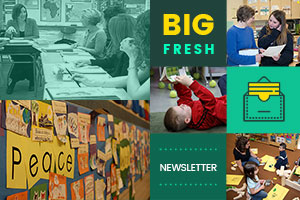I’ve always been interested in gadgets and technology, and I’ve always been a reader.
Levar Burton
What do Blinc mascara, coilers and toothpaste squeezers have in common? They are all superior replacements for previous products I’ve owned. One of the things that bothered me about mascara was that it either “ran” or was so waterproof I couldn’t get it off without buying a specific chemical or cream. Then I discovered Blinc mascara which actually “tubes” your lashes and comes off easily with a little eyelash massage and warm water. Similarly, I had an eight-year-old struggling to double knot leather or too-short laces to keep them tied. My mom found “coilers” which look like curly pigs’ tails and turn lace-up shoes into slip-on shoes that stay tight and tied. Then just last week, Maya and Ahna went to the dentist and brought home a flat plastic monkey face. When you insert the end of the toothpaste tube into the monkey’s straightline mouth, it pushes the toothpaste up and keeps it from being wasted.
Although I’ve watched a few episodes of Inspector Gadget in my day, I’m not a gadget gal. I like things simple. Still when I find products that solve problems, save time or minimize waste, I can get a little excited. In fact, my journey to replace make-up, shoelaces and dental utensils has led me to several considerations that also apply to replacing curriculum and educational tools.
1. What does this replacement do better? Does it do it better for the same or less cost?
2. What will I lose from making the switch from the old to the new?
3. What time and energy will be required to make a switch?
4. Will it free up my time and energy to do more of what’s really important?
A principal and I recently sat down with a new writing curriculum he was excited about and wanted to consider purchasing for his school. When we really looked at what it did better he admitted that the only improvement was that it had mentor texts provided. The organization of the mentor text lessons didn’t fit the writing workshop structure, so it would take retrofitting in the form of teacher time and energy. In the end, he decided that the new writing curriculum wasn’t as great as it originally seemed and that investing in teachers’ time and new mentor texts was probably a better way to go. While no new gadget was purchased, the questioning clarified for both of us why it wasn’t worth the switch.
This week we focus on summaries and authentic writing in this digital age. Plus more as always — enjoy!
Heather Rader
Senior Editor, Choice Literacy
Free for All
[For sneak peeks at our upcoming features, quotes and extra links, follow Choice Literacy on Twitter: @ChoiceLiteracy or Facebook: http://www.facebook.com/ChoiceLiteracy or Pinterest: http://pinterest.com/choiceliteracy/]
Heather Rader helps a sixth-grade teacher whose students are writing “dreadful” summaries by showing her how to provide more support and quality models:
http://www.choiceliteracy.com/articles-detail-view.php?id=737
What is “authentic” writing in this digital age? Summaries are a large part of the equation, from writing thoughtful captions to succinct tweets. Susan Lucille Davis lists the many kinds of writing students of all ages must be able to tackle in a socially mediated world:
Kevin Hodgson has a creative take on summaries, challenging his students to write research project summaries “tweet-style” in 15 words or less:
Learn more about the digital writing elements in Kevin Hodgson‘s middle school workshop in this podcast from the Choice Literacy archives:
http://www.choiceliteracy.com/articles-detail-view.php?id=1182
For Members Only
After over a decade of success, Karen Terlecky finds her reading response letter writing program is ready for some changes. In Rethinking Mrs. T Letters, she explains how she integrates more choice into the program through technology, while still using the letters as a vehicle for building rapport with students and summary skills:
http://www.choiceliteracy.com/articles-detail-view.php?id=1429
Sean Moore confers with a second grader in this week’s video, focusing on adding more details and descriptive language to his piece. This is the second installment in a four-part series:
http://www.choiceliteracy.com/articles-detail-view.php?id=1430
In Eliminating the Conga Line: Teaching Young Children About Strategic Thinking, Clare Landrigan and Tammy Mulligan manage to synthesize workspace cleanup, student independence, and a concrete analogy for strategy work in classrooms:
http://www.choiceliteracy.com/articles-detail-view.php?id=1426
Melissa Styger’s Writers Inspiring Writers program brings colleagues and family members into the classroom to share their writing process with students. Melissa teaches fourth graders, but this suggestion works for any grade level:
http://www.choiceliteracy.com/articles-detail-view.php?id=1428
Stella Villalba incorporates more speaking and listening activities into her primary classroom for English language learners. These activities are tied to the speaking and listening standards in the Common Core:
http://www.choiceliteracy.com/articles-detail-view.php?id=1427
That’s all for this week!



